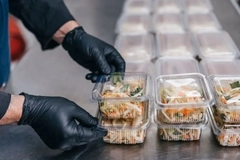UK consortium looks to functionalized nanomaterials to boost film barrier properties

23 Aug 2022 --- The HiBarFilm2 consortium, a group of nine research groups and companies in the UK, is collaborating to create a monomaterial polyolefin flexible film to replace traditional, hard-to-recycle multi-layered films.
Multilayer flexible films are currently a necessity in the food industry, extending the shelf life of many perishable products and saving vast amounts of greenhouse gas (GHG) emissions.
The combination of multiple polymer layers provides barrier performance – controlling the transmission rate of oxygen and water, and controlling puncture and tear resistance and heat sealability.
However, these designs – while ultimately beneficial in preventing food waste – are difficult to reprocess and usually result in landfilled plastic. The HiBarFilm2 project aims to solve this issue by using plasma functionalized nanomaterials.
“Previous work as part of the HiBarFilm feasibility study demonstrated that Haydale’s plasma functionalized nanomaterials can be used to influence barrier performance in films,” Keith Broadbent, CEO at consortium member Haydale, tells PackagingInsights.
 The consortium want to produce a monomaterial film capable of performing as multilayer structures currently do.“We are pleased to be leading the next stage project to develop further nanomaterial-enhanced coatings that will be a first in food contact applications, which could change the face of food packaging for the future and offer sustainable consumer solutions.”
The consortium want to produce a monomaterial film capable of performing as multilayer structures currently do.“We are pleased to be leading the next stage project to develop further nanomaterial-enhanced coatings that will be a first in food contact applications, which could change the face of food packaging for the future and offer sustainable consumer solutions.”
Functionalized nanomaterials
The effort of the project aims to increase barrier performance in two ways; firstly, by mixing the nanomaterials directly into the polyolefin before filming, adding barrier properties to the film itself – both polyolefin films and compostable plastics will be used to address the issue with contamination of films with food waste such as fats and blood.
Secondly, it can improve barrier performance by dispersing the nanomaterials into a barrier coating which can be applied to the polyolefin substrate.
The advantage is that the two solutions can be combined to increase the barrier performance further. By manufacturing monomaterial flexible films, the recyclability of these materials will increase, and value will be added.
“Nanomaterials such as graphene are inert, and unless you can get them to disperse uniformly, there are very few applications that will benefit from the performance-enhancing properties such materials afford,” says Dr. Kayleigh McEwan, Haydale senior development engineer.
Using Haydale’s patented HDPlas process, bespoke chemistries can be added to the surface of nanomaterials and common barrier additives, allowing them to be dispersed in polymer matrices.
Covalent bonding
The spokesperson explains that Plasma functionalization allows them to covalently attach specific functional groups to the additives to improve dispersion, and compatibility or add hydrophobicity to enhance water barrier properties.
“The plasma treatment process is fully tunable with a range of different chemistries available with the ability to target varying levels of functionalization.”
“No solvents or harsh chemicals are used in this powder in, powder out, environmentally friendly process.”
Innovate UK funds the project within the Industrial Strategy Challenge Fund. It has a funded value of £707,788 (US$830,679).
The project is a 30-month-long program containing ten work packages run between the consortium partners. This will be assessed within the project to ensure any developed products are in line with the cost of current multi-layered solutions or provide a scaled performance at an increased cost.
By Louis Gore-Langton











